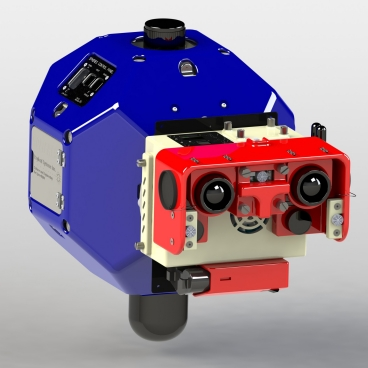By Kalwinder KaurAug 6 2012
MIT researchers envision robots to play a major role in future space missions. Robots can be set out for missions that are hazardous or impossible for humans.
 Rendering of the VERTIGO
Rendering of the VERTIGO
MIT’s Space Systems Laboratory (SSL) researchers are currently formulating software for controlling robotic inspectors in space. Research team has been testing algorithms on robotic platforms, MIT-built volleyball-sized droids called SPHERES. These platforms are now onboard the microgravity environment of the International Space Station (ISS), where the robots fly in midair, similar to that in outer space. These robots are being programmed with better interaction capabilities.
Researchers at MIT and the University of Maryland will develop and provide two hardware upgrades for Synchronized Position Hold, Engage, Reorient Experimental Satellites (SPHERES).
- The first upgrade is a two-camera setup ‘VERTIGO’, which will be installed anterior to the SPHERES, resembling goggles. Images from the cameras will facilitate creating algorithms for vision-based navigation.
- The second upgrade ‘RINGS’ are large electromagnetic rings enclosing each SPHERES robot. The electromagnetic coils present in the rings act as giant magnets that either repel or attract the SPHERES, based on the current within the ring. Magnets can also drive the robots wirelessly.
The innovative SPHERES developments were recently presented at the American Astronautical Society’s ISS Research and Development Conference in Denver.
Researchers focus on formulating algorithms for robots capable of operating external to the ISS.
VERTIGO (Visual Estimation and Relative Tracking for Inspection of Generic Objects) and RINGS (Resonant Inductive Near-field Generation System) will enable the researchers to learn the dynamics existing between rotating object and a robot, thereby promoting the creation of algorithms for potential robotic space inspectors. By integrating the new hardware and software on SPHERES, future robots can be used for building new ones in space in addition to inspecting old spacecraft.
VERTIGO is expected to be launched on a rocket to the ISS in October, and RINGS in December 2012.
Disclaimer: The views expressed here are those of the author expressed in their private capacity and do not necessarily represent the views of AZoM.com Limited T/A AZoNetwork the owner and operator of this website. This disclaimer forms part of the Terms and conditions of use of this website.